
Bootstrapping Disk Backups on Your Own

Bootstrapping Disk Backups on Your Own
Cloning involves moving data from one storage device to another (in this case, a hard drive) such that an exact copy is duplicated in the destination drive. It might be helpful for several reasons, including transfer, recovery, or simply backup of existing data.
But why is this necessary in the first place, and what makes it a preferred solution? Let’s dive into these questions and learn about hard drive cloning mechanisms you can use to move or copy your data.
Cloning Your Hard Drive: What This Means
Hard drives and SSDs can fail, leading to data loss. If you’re already gettingsigns that your hard drive is failing or experiencingsymptoms from an SSD that’s about to give up , you should consider cloning them. That way, you can keep your data secure when your storage drives fail.
Also, if you want to upgrade your drive to a different one, cloning it will make data transfer easier while retaining its existing configuration. This differs from a backup, which copies your files only.
Furthermore, the cloning process will duplicate the entire content of your drive, keeping it as original as the source drive. Hence, a perfect copy of your hard drive, including the operating system, file systems, hard drive partitions, and even programs.
As such, this makes it the perfect thing to do when switching PCs. The cloned drive retains everything, so you can get your new PC up and running quickly.
Now that we’ve explored why, let’s get into the guidelines for cloning your hard drive.
How to Clone Your Hard Drive Without Software

Cloning your drive can be done in two ways: using the System Image function on your Windows 11 PC or with the help of third-party software. While not exactly a clone, the first option can work just like one. In this case, your computer creates a compressed file storing all the copied data. It’s functional for creating a backup since you can save multiple copies of your drive image routinely on a drive.
On the other hand, cloning copies your drive data as is, requiring no installation on the destination or target drive. This means your PC will immediately boot and run once your clone is inserted.
Hence, the difference lies in how your data is stored, but they perform the same essential function. However, imaging is the closest to cloning you can accomplish with your Windows 11 PC without third-party software. Here’s how you can create a system image:
- Locate theControl Panel on your PC using the search function or clicking the shortcutWin + R and type in “control panel” to launch it**.**
- From there, clickSystem and Security and then navigate toBackup and Restore Windows (Windows 7) from the list.

- On the sidebar, clickCreate a System Image.

- You’ll see three options:On a Hard Disk, On One or More DVDs, andOn a Network Selection. ClickOn a Hard Disk and select one from the drop-down menu,having connected your drive to your PC .

5. ClickStart Backup.

6. Wait for the process to be completed, after which the Image backup file will be saved on your drive, which can be restored later.
With this, you’ll have an image of your current drive saved to your other drive.
Cloning Is Your Best Bet for Keeping Your Hard Drive Secure
A hard drive is as important as what is stored in it, so you must keep data protected so it maintains its integrity over time against potential data threats. Thankfully, we’ve explored a foolproof method to protect your data—cloning.
The hard drive clone process is smooth, and what is more secure than having a clone of your PC files and programs that can be restored at any time?
Also read:
- [New] 2024 Approved X-Recorder for Pc Audio Logger at No Cost
- [New] In 2024, Spark Interest and Build Community Through These 10 IGTV Approaches
- [Updated] In 2024, 12 Proven Ways to Increase YouTube Views You Should Try
- [Updated] In 2024, ZeroBackground Pro Precision Erasing for Photos
- 1. Comprensivo Guía Para Solucionar El Acceso a WD My Cloud Desde Windows 10: Pasos Fáciles Y Rápidos
- Comprehensive Orbi Wi-Fi 6 Mesh Network Test: Ensuring Speedy Connection Everywhere in the Home
- Decreasing High CPU Demand of Cloud Storage on Windows PCs
- Elevate File Handling Excellence: Harnessing Win 11’S Copy & Move
- In 2024, Advanced PIP Setup Elevating Your Visual Presentations on macOS
- In 2024, Essential 5 Virtual Film Maker Gadgets
- In 2024, How to Transfer Contacts from Motorola Edge 40 Neo to iPhone XS/11 | Dr.fone
- Navigating Through Windows Photos Package Registration Faults
- Overcoming 'Entry Point Not Found' On Windows PC
- Quick Fixes for Keyboard Lag on Microsoft's Newest OS
- Quick Fixes for Speedy Epic Game Installations
- Quieting Chrome Ads & Alerts on Windows Machines
- Top 8 Free Sites for Accessing 3D Text PSD Images for 2024
- Unlock Windows Free Up Space, No More Temp Files!
- ViVeTool Explained: How to Access Next-Gen Windows Tools
- Title: Bootstrapping Disk Backups on Your Own
- Author: Richard
- Created at : 2025-01-20 21:37:32
- Updated at : 2025-01-24 20:47:39
- Link: https://win11-tips.techidaily.com/bootstrapping-disk-backups-on-your-own/
- License: This work is licensed under CC BY-NC-SA 4.0.

